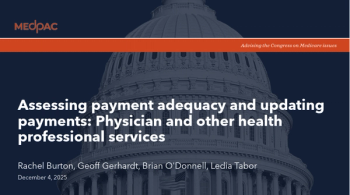
- October 25, 2018 edition
- Volume 95
- Issue 20
Toby Cosgrove heads to Google
What does his move mean for digital healthcare?
When Delos “Toby” Cosgrove, MD, stepped down from the helm of Cleveland Clinic, where he had served as chief executive officer since 2004, few thought he was ready to exit the healthcare industry altogether.
Still, many were surprised when Gregory Moore, MD, vice president at Google Cloud, announced in a July 19, 2018 blog post that Cosgrove would be joining the company as executive advisor to the Google Cloud Healthcare and Life Sciences team. But in an email to Medical Economics, Cosgrove says Google Cloud’s mission to make healthcare information “accessible, useful, and secure” appealed to him.
“This team is making huge inroads in helping to balance the advances in digital health with the impact on those who provide care,” Cosgrove writes. “I’m thrilled to join them and look forward to continuing Google Cloud’s mission to improve provider efficiency and patient care through the use of technology.”
Cosgrove’s move follows other high-profile moves of individuals prominent in the healthcare industry into technology-related positions. Thomas Insel, MD, left the National Institutes of Mental Health in 2015 to join Google’s Verily, and recently left there to create his own healthcare technology start-up.
Meanwhile, famed surgeon and author Atul Gawande, MD, has taken command of the new Amazon-Berkshire-JPMorgan Chase healthcare partnership. But while these healthcare “defections” make headlines, it’s often unclear what such illustrious physicians have to offer these technology companies. What is the potential impact of Cosgrove’s new role with Google Cloud on the healthcare field-and the company’s position in it?
A matter of trust
As noted in a recent IDC Health Insights Survey, among the biggest barriers to cloud adoption in healthcare are concerns over the privacy and security of patient data.
Vince Vickers, MBA, a principal at KPMG Healthcare and Life Sciences, who has conducted cloud migrations for several healthcare systems, says that many organizations may have preconceived notions about Google as a secure cloud provider. Vickers says Google’s success in consumer data mining might make some wary of using them to help secure patient health information.
“Bringing in someone like Dr. Cosgrove, who is an icon in the industry-someone who has been successful as a physician and as a businessman in the healthcare space and really understands the challenges in this space-goes a long way to building that trust,” he says. “It can help make healthcare providers more comfortable with the idea of Google, and what Google Cloud might be able to offer to assist them.”
Such an eminent hire, Vickers says, can help healthcare organizations believe that Google Cloud is trustworthy-and can provide the tools to keep patient health information private.
Reconciling the push and pull of cloud adoption
Lynne Dunbrack, MS, MBA, vice president of research at IDC Health Insights, says that many healthcare organizations have conflicting feelings about cloud adoption.
IDC’s 2018 Cloud Adoption Trends survey suggests that security remains a top concern for healthcare organizations considering cloud adoption-yet those same organizations also understand that cloud solutions can help make their organizations more secure. Dunbrack says this seemingly contradictory finding is due to many organizations’ lack of experience with cloud solution technologies. This ambivalence remains a bit a conundrum for the industry-and one that could use the right leadership to resolve.
Dunbrack says that many organizations feel overwhelmed by cloud offerings-but Cosgrove’s hire, and the resulting education and outreach efforts, may help healthcare organizations better balance their worries concerning cloud adoption and find the solutions that will work best for them.
“Cosgrove’s reputation in the industry speaks volumes. The fact that he’s getting behind these initiatives and lending his professional talent and expertise speaks to Google’s commitment to understanding the specific needs involved with healthcare and the needs involved with healthcare cloud in particular. It puts Cosgrove, and Google Cloud, in a really good position to guide others,” says Dunbrack.
Cosgrove writes that’s why one of his principal efforts at Google Cloud will be to educate healthcare professionals regarding the benefits of moving to the cloud.
“Google Cloud believes it is important to work with partners across the ecosystem-patients, providers, insurers, and researchers-to unlock important data and deliver it to where it is needed most,” Cosgrove explains.
Furthering the healthcare mission
Cosgrove says that his mission at Google Cloud will be to help healthcare organizations simultaneously improve clinician workflow and the quality of patient care using innovative technologies.
“As the executive advisor, my goal is to use expertise to help the Google Cloud Healthcare and Life Sciences team educate healthcare professionals on the benefits of moving to the cloud and how it can improve not only the work experience of clinicians and staff but also patient experiences,” he says.
Both Vickers and Dunbrack believe he is in a unique position to do so. Vickers says that Cosgrove’s experience will be a boon to Google Cloud as they extend their reach in the healthcare industry.
“This is a guy with an amazing background who really understands the nuances of healthcare,” says Vickers. “I think Google Cloud having someone like Cosgrove on board, someone who understands the needs and the challenges, is going to be a big benefit for them-and for cloud adoption in general.”
Dunbrack agrees. “There are a lot of benefits to being in the cloud, especially with regards to becoming more agile and bringing new systems online,” she says. “Having a high profile executive like Toby Cosgrove on board is certainly going to be very helpful to Google Health as they move forward and demonstrate their commitment to working in healthcare.”
Articles in this issue
about 7 years ago
2018 EHR Report Cardabout 7 years ago
Trapped in an EHRabout 7 years ago
A young physician’s view on EHRsabout 7 years ago
Physicians' EHR work-aroundsabout 7 years ago
She doesn't have a doorabout 7 years ago
Four tips for successful cybersecurity trainingabout 7 years ago
An interoperability breakthrough?about 7 years ago
The paper chart holdoutsover 7 years ago
12 things doctors should consider before a major tech investmentNewsletter
Stay informed and empowered with Medical Economics enewsletter, delivering expert insights, financial strategies, practice management tips and technology trends — tailored for today’s physicians.














